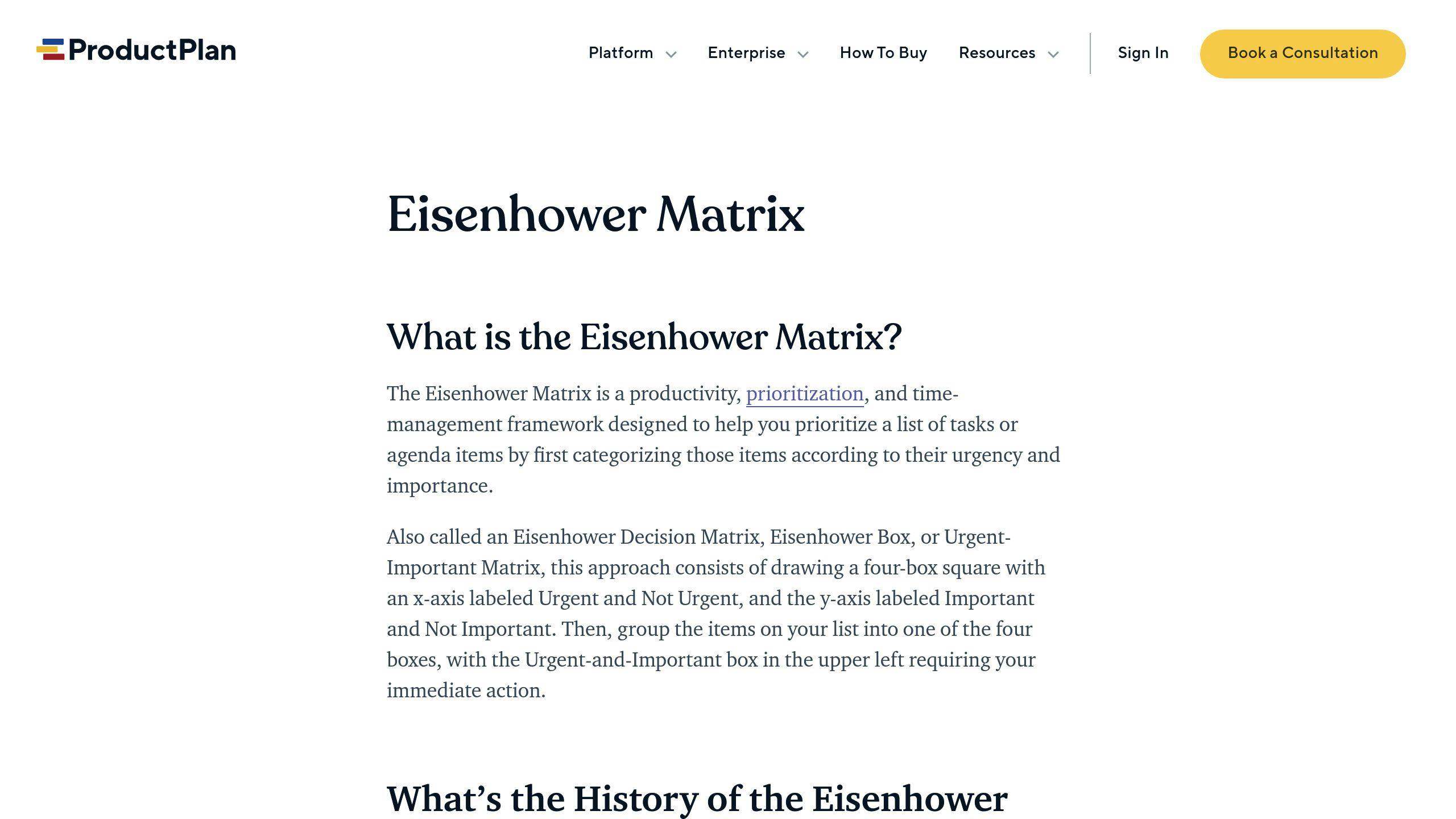
Feeling overwhelmed by your to-do list? Here’s how to prioritize tasks and boost productivity:
- Eisenhower Matrix: Sort by urgency and importance
- MoSCoW Method: Group tasks into must-haves, should-haves, could-haves, and won’t-haves
- Time Boxing: Set time limits for tasks
- Value vs Effort Matrix: Plot tasks based on value and effort required
- Hardest Task First: Tackle the toughest job early
- Task Importance Comparison: Compare tasks pairwise to rank importance
Quick Comparison:
| Technique | Best For | Key Benefit |
|---|---|---|
| Eisenhower Matrix | Big projects | Focuses on what matters most |
| MoSCoW Method | Agile development | Clarifies task priorities |
| Time Boxing | Deadline-driven work | Improves focus and pacing |
| Value vs Effort | Feature decisions | Balances impact and workload |
| Hardest Task First | Productivity boost | Builds momentum early |
| Task Importance Comparison | Shorter task lists | Fine-tunes priorities |
Pick one method or mix and match. The goal? Do what matters, stress less, and crush those deadlines.
What is Task Prioritization?
Task prioritization is like sorting your code. You fix critical bugs before adding new features. It’s about ranking your to-dos based on importance and urgency.
Basic Definition
Task prioritization means deciding what needs doing now, what can wait, and what you might skip. It’s that simple.
For web devs, it’s choosing to fix a major security flaw on a live site over tweaking colors on a work-in-progress landing page.
How Web Developers Benefit
Mastering task prioritization helps web devs:
- Hit deadlines
- Boost work quality
- Cut down stress
- Keep clients in the loop
Here’s how prioritization changes a dev’s day:
| Without It | With It |
|---|---|
| Task-hopping | Focused work |
| Missing deadlines | On-time delivery |
| Stress overload | Smooth workflow |
| Bugs slip through | Key features tested well |
Fun fact: 22% of folks in a 2022 product management survey said prioritization was their biggest challenge. You’re not alone if you find it tough!
“Prioritization is not about doing more things right, but about doing the right things.” - Peter Drucker
Prioritization isn’t just about getting more done. It’s about doing what matters most.
Getting Ready to Prioritize
Before you start prioritizing, you need to do two things: make a full task list and set clear goals.
Making a Complete Task List
List EVERYTHING you need to do:
- Project work
- Bug fixes
- Feature requests
- Code reviews
- Meetings
- Learning new skills
Don’t skip anything. A full list shows you exactly what you’re dealing with.
Tip: Use a tool like Jira or Trello to keep your list organized.
Setting Clear Project Goals
Now that you have your list, it’s time to set goals. Good goals help you focus on what matters.
For each project, figure out:
- What’s the main goal?
- What are the big steps?
- When does it need to be done?
- How will you measure success?
Here’s what this might look like for a web app project:
| What | Example |
|---|---|
| Main Goal | Build a responsive online store |
| Big Steps | 1. Finish product catalog 2. Add shopping cart 3. Set up payments |
| Deadline | March 15, 2024 |
| Success Measures | - 99% uptime first month - Pages load in 3 seconds - 2% of visitors buy something |
Setting specific goals gives you a map for your work. It makes it easier to decide what’s most important.
But remember: goals can change. Check them often and adjust if needed. This keeps your priorities in line with what the project needs.
Now that you’ve got your list and goals, you’re ready to start prioritizing. Next, we’ll look at some ways to tackle your work efficiently.
6 Ways to Prioritize Tasks
You’ve got your task list and project goals. Now, let’s dive into six effective ways to prioritize your work:
1. Eisenhower Matrix

The Eisenhower Matrix sorts tasks by urgency and importance:
| Urgent | Not Urgent |
|---|---|
| Important: Do now | Important: Schedule |
| Not Important: Delegate | Not Important: Drop |
Example: A critical bug fix? “Do now.” Planning a new feature? “Schedule.”
2. MoSCoW Method

Group tasks into four buckets:
- Must have: Critical
- Should have: Important
- Could have: Nice-to-have
- Won’t have: Not this time
User authentication? “Must have.” Dark mode? “Could have.”
3. Time Boxing
Set time limits for tasks:
- Choose a task
- Set a timer (25 minutes)
- Work until it rings
- Take a break
Great for code reviews or bug fixes. Keeps you moving, fights perfectionism.
4. Value vs Effort Matrix
Plot tasks on this grid:
| High Value, Low Effort | High Value, High Effort |
|---|---|
| Low Value, Low Effort | Low Value, High Effort |
Start with high-value, low-effort tasks. Like optimizing your most-visited webpage.
5. Hardest Task First
Kick off your day with the toughest task. Maybe it’s:
- Cracking a complex coding problem
- Writing docs for a tricky feature
- Refactoring messy code
You’ll feel accomplished early on.
6. Task Importance Comparison
Use the bubble sort method:
- List tasks
- Compare first two
- Put the more important one first
- Move to next pair
- Repeat
Works well for shorter lists. Helps you zero in on what really matters.
Using These Techniques in Practice
Let’s talk about how to actually use these prioritization methods to boost your productivity as a web developer.
Picking the Best Method
Different projects need different approaches. Here’s a quick guide:
| Project Type | Go-To Technique |
|---|---|
| Big, complex projects | Eisenhower Matrix |
| Agile development | MoSCoW Method |
| Time-crunched tasks | Time Boxing |
| Feature decisions | Value vs Effort Matrix |
For example: Building a huge e-commerce site? The Eisenhower Matrix can help you sort out what’s really important. Critical security updates? Urgent and important. Fancy UI tweaks? Not so much.
Mixing and Matching
Sometimes, one method isn’t enough. Try these combos:
- Eisenhower Matrix + Time Boxing: Tackle the urgent, important stuff in focused bursts.
- MoSCoW + Value vs Effort: Take your “Should haves” and plot them on the effort-value grid.
Here’s a real-world win: An Asana product manager used both MoSCoW and Value vs Effort. The result? They cut feature bloat by 30% in their latest release.
Rolling with the Changes
Projects evolve, and so should your priorities:
-
Weekly priority check: 39% of product managers do this to stay on track.
-
Quick team huddles: Spot new urgent items or roadblocks fast.
-
Digital tools are your friend: Trello or Jira make it easy to shuffle tasks around.
Bottom line: Prioritization isn’t a set-it-and-forget-it deal. It’s ongoing. As Stephen Covey put it: “The key is not to prioritize what’s on your schedule, but to schedule your priorities.”
Common Mistakes and How to Fix Them
Web developers often mess up task prioritization. Here are three big mistakes and how to avoid them:
Treating Everything as “Important”
Marking all tasks as high-priority? That’s a recipe for burnout.
Fix: Use the Eisenhower Matrix:
| Urgent | Not Urgent |
|---|---|
| Do it now | Schedule it |
| Delegate it | Dump it |
Focus on ONE important task at a time. Quality over quantity, folks.
Forgetting Long-Term Projects
Daily fires are distracting. But don’t let ongoing work slip through the cracks.
Fix: Block out time for long-term stuff. Use the MoSCoW method:
- Must-haves: Can’t live without ‘em
- Should-haves: Important, but not deal-breakers
- Could-haves: Nice extras
- Won’t-haves: Not this time
Sticking to Outdated Priorities
Projects change. Your priorities should too.
Fix: Do a weekly priority check. Use this simple A-B-C system:
- A: Drop everything
- B: Important, but can wait
- C: Nice to have
Tackle A’s first, then B’s, then C’s.
Remember: Prioritization isn’t set-and-forget. It’s an ongoing process. Keep adjusting, and you’ll stay on top of your game.
Conclusion
Task prioritization can supercharge your web development workflow. Here’s the deal:
-
There’s no perfect method. The Eisenhower Matrix might click for you, or maybe Time Boxing’s your thing.
-
Stay flexible. Priorities change, so your system should too.
-
Don’t go all-in at once. Pick one technique for your next project and see how it goes.
-
Mix it up. Use MoSCoW for big-picture planning, then Time Box your daily grind.
-
Check-in weekly. Reassess your priorities regularly - it’s not a set-it-and-forget-it deal.
Master these, and you’ll crush deadlines with less stress. Simple as that.
FAQs
How do you prioritize your work as a web developer?
As a web developer, prioritizing work is key. Here’s how to do it:
- List all tasks
- Focus on deadline-driven items
- Use the Eisenhower Matrix
- Keep long-term goals in mind
- Create a timeline or checklist
The Eisenhower Matrix helps categorize tasks into four buckets: urgent and important, important but not urgent, urgent but not important, and neither urgent nor important.
How do developers manage their time?
Developers use several strategies to manage their time effectively:
- Set clear goals
- Break big tasks into smaller ones
- Use time-blocking
- Avoid multitasking
- Take regular breaks
- Use project management tools
- Limit distractions
“Planning is everything. We talk about this when creating software; research takes up 80% of your energy, while 20% is spent completing the actual work.”
This approach helps developers stay on track and meet deadlines without compromising quality.
